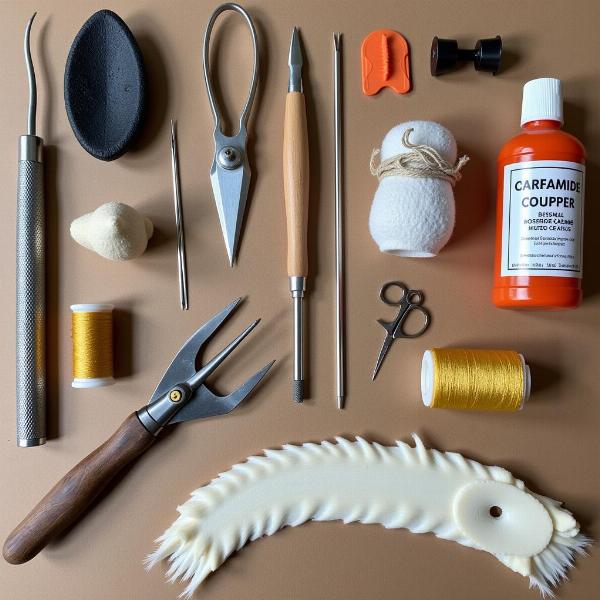Understanding the meaning of “taxidermist” in Hindi can be tricky. This article explores the various Hindi translations, delves into the art of taxidermy, its cultural significance, and its connection to professions like museum curation and wildlife preservation. We’ll also look at the ethical considerations surrounding this practice. So, if you’re curious about “taxidermist meaning in Hindi” and all it entails, you’re in the right place.
What Does “Taxidermist” Mean in Hindi?
The English word “taxidermist” translates to several terms in Hindi. The most common and accurate translation is चर्मसंहारक (charmsanhārak). This term literally means “skin arranger” or “one who arranges skin.” Other less common terms include पक्षी भरने वाला (pakshi bharne wala) for someone who stuffs birds and जानवर भरने वाला (jaanvar bharne wala) for someone who stuffs animals. While these terms are more descriptive of the process, they lack the professional connotation of “charmsanhārak.”
The Art of Taxidermy: More Than Just Stuffing
Taxidermy is the art of preserving the skin of an animal, bird, or fish and mounting it on a form to create a lifelike representation. It’s a complex process involving cleaning, tanning, and shaping the skin, followed by carefully positioning it over a sculpted form. It requires artistic skill, anatomical knowledge, and a deep understanding of the animal being preserved.
Taxidermy in India: History and Culture
While not as prevalent as in some Western cultures, taxidermy has a history in India, particularly during the British Raj. Hunting trophies were often preserved through taxidermy, a practice that continues in some circles today. However, with growing awareness about wildlife conservation, ethical concerns around taxidermy are also increasing.
Taxidermy and Conservation: A Complex Relationship
Taxidermy can play a role in conservation by providing educational resources for museums and research institutions. Preserved specimens allow scientists to study animal anatomy, evolution, and the impact of environmental changes. However, the ethical sourcing of specimens is crucial to ensure that taxidermy doesn’t contribute to the decline of endangered species.
Careers in Taxidermy and Related Fields
Becoming a taxidermist requires specialized training and apprenticeships. Related fields include museum curation, wildlife biology, and taxidermy supply businesses. These professions offer opportunities for individuals passionate about animals and natural history.
 Modern taxidermy tools and materials used for preservation.
Modern taxidermy tools and materials used for preservation.
What are the Ethical Considerations of Taxidermy?
The ethical aspects of taxidermy are often debated. It’s essential to ensure that animals used in taxidermy are sourced ethically and not killed specifically for this purpose. Reputable taxidermists prioritize working with animals that have died from natural causes or accidents.
Conclusion: Understanding “Taxidermist Meaning in Hindi” and Beyond
This article has explored the “taxidermist meaning in Hindi,” delving into the art, history, and ethical considerations surrounding this practice. While चर्मसंहारक (charmsanhārak) is the most accurate Hindi translation, understanding the broader context of taxidermy offers a more complete picture. From its role in museums to its connection with wildlife conservation, taxidermy remains a complex and fascinating field.
FAQ
- What is the primary Hindi word for taxidermist? The primary Hindi word for taxidermist is चर्मसंहारक (charmsanhārak).
- Is taxidermy legal in India? The legality of taxidermy in India depends on the species involved and the source of the animal. Endangered species are protected, and their use in taxidermy is strictly regulated.
- Where can I learn taxidermy? There are specialized schools and workshops offering taxidermy training, often through apprenticeships.
- How much does a taxidermist earn? Earnings vary depending on experience and the type of work. Experienced taxidermists can earn a substantial income.
- What is the future of taxidermy? The future of taxidermy hinges on ethical practices and its continued role in education and conservation.
- Are there alternatives to traditional taxidermy? Yes, alternatives like 3D printing and digital modeling are emerging, offering ways to create lifelike animal representations without using real animal skins.
- What is the difference between a taxidermist and a taxidermy artist? While the terms are often used interchangeably, a “taxidermy artist” may emphasize the artistic and creative aspects of the craft, while “taxidermist” may refer to the technical skills involved.
Meaning-Hindi.in offers professional translation services specializing in various fields, including technical, legal, and educational documents. Whether you need to translate documents related to wildlife conservation, museum exhibits, or any other specialized field, our expert translators ensure accurate and culturally sensitive translations. Contact us today for all your Hindi translation needs at [email protected] or call us at +91 11-4502-7584. Meaning-Hindi.in is your trusted partner for all your Hindi translation requirements.